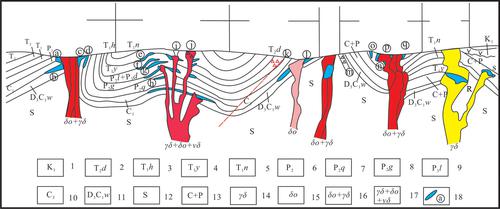当前位置:
X-MOL 学术
›
Acta Geol. Sinica Engl. Ed.
›
论文详情
Our official English website, www.x-mol.net, welcomes your feedback! (Note: you will need to create a separate account there.)
Deep Mineralization Background and Metallogenic Regularity of the Tongling Ore District
Acta Geologica Sinica-English Edition ( IF 3.3 ) Pub Date : 2020-12-08 , DOI: 10.1111/1755-6724.14606 Qiu WAN 1, 2, 3 , Jianguo DU 1, 2 , Bo YANG 1, 2 , Xueyi LAN 2, 4 , xiao XIAO 2, 5 , Ke SHI 1, 2
Acta Geologica Sinica-English Edition ( IF 3.3 ) Pub Date : 2020-12-08 , DOI: 10.1111/1755-6724.14606 Qiu WAN 1, 2, 3 , Jianguo DU 1, 2 , Bo YANG 1, 2 , Xueyi LAN 2, 4 , xiao XIAO 2, 5 , Ke SHI 1, 2
Affiliation

|
Based on the geological conditions and characteristics of mineralization present, three‐dimensional geological modelling is used in conjunction with previous deep research results, in order to discuss the process of deep mineralization in the Tongling ore district. The structural analysis shows that surface deformation is strong, deep deformation is weak, the surface has mainly experienced brittle deformation, with the possibility of a large number of deep ductile deformations. There is a thrust nappe between the Tongling uplift and the Nanling basin, that is the boundary of the Tongling block, which has resulted in the southwest uplift of the Tongling block. Combined with the deep exploration data, the three‐dimensional shape of the main rock masses is interpreted, with three‐layer structures in the deep magma chamber. The spatial distribution of magmatic rocks is mainly controlled by the structure. The movement of magmatic hydrothermal fluid is dominated by mesoscale seepage in the deep part and ‘dike’ type upwelling in the shallow part. There is a certain coupling relationship between the ore‐forming rock mass and the surrounding rock. The ore‐forming age is dominated by the Yanshanian period. Based on the distribution, types and metallogenic characteristics of the deposits, the metallogenic model of ‘layer coupling’ in the Tongling ore district is summarized, with the ‘one body, two belts and a multilayer metallogenic system’ is established, which is significant for the future direction of deep prospecting in the Tongling area.
中文翻译:

铜陵矿区深部矿化背景及成矿规律
根据目前的地质条件和成矿特征,结合以往的深入研究成果,运用三维地质建模方法,对铜陵矿区的深部成矿过程进行了探讨。结构分析表明,表面变形强,深层变形弱,表面主要经历了脆性变形,有可能发生大量的深延性变形。铜陵隆起与南岭盆地之间有一个逆冲推覆作用,即铜陵地块的边界,这导致了铜陵地块的西南隆升。结合深部勘探数据,解释了主要岩体的三维形状,并在深部岩浆室内具有三层结构。岩浆岩的空间分布主要受构造控制。岩浆热液的运动主要由深部的中尺度渗漏和浅部的“堤”型上升形成。成矿岩体与围岩之间存在一定的耦合关系。成矿年龄主要由燕山期决定。根据铜矿床的分布,类型和成矿特征,总结了铜陵矿区“层耦合”成矿模式,建立了“一体,两带,多层成矿体系”,对深层沉积具有重要意义。铜陵地区深层找矿的未来方向。岩浆热液的运动主要由深部的中尺度渗漏和浅部的“堤”型上升所决定。成矿岩体与围岩之间存在一定的耦合关系。成矿年龄主要由燕山期决定。根据铜矿床的分布,类型和成矿特征,总结了铜陵矿区“层耦合”成矿模式,建立了“一体,两带,多层成矿体系”,具有重要意义。铜陵地区深层找矿的未来方向。岩浆热液的运动主要由深部的中尺度渗漏和浅部的“堤”型上升所决定。成矿岩体与围岩之间存在一定的耦合关系。成矿年龄主要由燕山期决定。根据铜矿床的分布,类型和成矿特征,总结了铜陵矿区“层耦合”成矿模式,建立了“一体,两带,多层成矿体系”,对深层沉积具有重要意义。铜陵地区深层找矿的未来方向。成矿年龄主要由燕山期决定。根据铜矿床的分布,类型和成矿特征,总结了铜陵矿区“层耦合”成矿模式,建立了“一体,两带,多层成矿体系”,对深层沉积具有重要意义。铜陵地区深层找矿的未来方向。成矿年龄主要由燕山期决定。根据铜矿床的分布,类型和成矿特征,总结了铜陵矿区“层耦合”成矿模式,建立了“一体,两带,多层成矿体系”,对深层沉积具有重要意义。铜陵地区深层找矿的未来方向。
更新日期:2020-12-30
中文翻译:

铜陵矿区深部矿化背景及成矿规律
根据目前的地质条件和成矿特征,结合以往的深入研究成果,运用三维地质建模方法,对铜陵矿区的深部成矿过程进行了探讨。结构分析表明,表面变形强,深层变形弱,表面主要经历了脆性变形,有可能发生大量的深延性变形。铜陵隆起与南岭盆地之间有一个逆冲推覆作用,即铜陵地块的边界,这导致了铜陵地块的西南隆升。结合深部勘探数据,解释了主要岩体的三维形状,并在深部岩浆室内具有三层结构。岩浆岩的空间分布主要受构造控制。岩浆热液的运动主要由深部的中尺度渗漏和浅部的“堤”型上升形成。成矿岩体与围岩之间存在一定的耦合关系。成矿年龄主要由燕山期决定。根据铜矿床的分布,类型和成矿特征,总结了铜陵矿区“层耦合”成矿模式,建立了“一体,两带,多层成矿体系”,对深层沉积具有重要意义。铜陵地区深层找矿的未来方向。岩浆热液的运动主要由深部的中尺度渗漏和浅部的“堤”型上升所决定。成矿岩体与围岩之间存在一定的耦合关系。成矿年龄主要由燕山期决定。根据铜矿床的分布,类型和成矿特征,总结了铜陵矿区“层耦合”成矿模式,建立了“一体,两带,多层成矿体系”,具有重要意义。铜陵地区深层找矿的未来方向。岩浆热液的运动主要由深部的中尺度渗漏和浅部的“堤”型上升所决定。成矿岩体与围岩之间存在一定的耦合关系。成矿年龄主要由燕山期决定。根据铜矿床的分布,类型和成矿特征,总结了铜陵矿区“层耦合”成矿模式,建立了“一体,两带,多层成矿体系”,对深层沉积具有重要意义。铜陵地区深层找矿的未来方向。成矿年龄主要由燕山期决定。根据铜矿床的分布,类型和成矿特征,总结了铜陵矿区“层耦合”成矿模式,建立了“一体,两带,多层成矿体系”,对深层沉积具有重要意义。铜陵地区深层找矿的未来方向。成矿年龄主要由燕山期决定。根据铜矿床的分布,类型和成矿特征,总结了铜陵矿区“层耦合”成矿模式,建立了“一体,两带,多层成矿体系”,对深层沉积具有重要意义。铜陵地区深层找矿的未来方向。


























 京公网安备 11010802027423号
京公网安备 11010802027423号